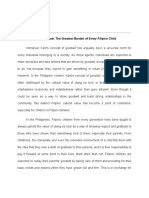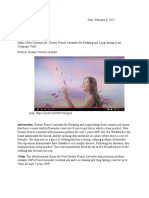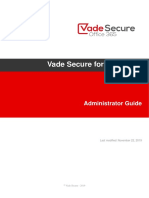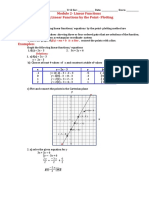Professional Documents
Culture Documents
Chapter 2
Chapter 2
Uploaded by
AJ CorpuzOriginal Description:
Original Title
Copyright
Available Formats
Share this document
Did you find this document useful?
Is this content inappropriate?
Report this DocumentCopyright:
Available Formats
Chapter 2
Chapter 2
Uploaded by
AJ CorpuzCopyright:
Available Formats
Page 30
CHAPTER 2
LANGUAGE, CONCEPT, AND TERM
These three: language, concept, and term, are the fundamental
aspects in the study of logic because logic is substantially concerned with
arguments, judgments, and reasoning. But no argument, judgment and
reasoning are possible without the use of language, concept, and term.
LANGUAGE
Corazon L. cruz quotes Copi’s list of basic functions of language. They
are: informative, expressive, and directive (1995; p. 11-12).
Informative
This is the most common function of language that is being attested
by textbooks on any subject, magazine, newspaper, etc. This is so because
information is most of the time(though not absolute) given, sent or received
through language. In logic, we see this function at work in propositions and
arguments, where something is either affirmed or denied. That which is
affirmed or denied is either true or false, correct or incorrect. When we
say, “Mo. Ignatia del Spiritu Santo is the foundress of the congregation of
the Religious of the Virgin Mary”, we are giving a true information by
affirming Mo. Ignatia as the foundress of the RVM congregation. When we
say, “Rodrigo Duterte is not the present Mayor of Davao City”, we are again
giving a true information but by denying that Rodrigo Duterte is the present
mayor of Davao City. When we say, “GMA is the first president of the
Republic of the Philippines”, we are giving a false information by affirming
something which is not true. A false information can also be given by denying
something which is actually true like: “MT. Apo is not the highest mountain in
the Philippines”.
Expressive
Intro.to Philosophy: Logic Cayogyog/Parantar
Page 31
This function of language is commonly seen in the expression of
thoughts and feelings like that of poetry. This is also seen in common
exclamations like “Oh no!”, “right”, “Ah, Ha!”, etc. which express different
moods of feelings and emotions. This function of language therefore, is used
to express the speaker’s feelings or to evoke certain feeling on the part of
the author or, both. The examples for this function of language are
oratorical speeches, Sunday Homilies, etc.
Directive
This function of language is commonly seen in commands and request,
e.g. “get me a piece of chalk”; “may I have my pen”, and “ Please sing me the
song ‘Esperanza’”.
Note that the second and third functions of language cannot speak of
something as true or false. So, logic is concerned only with the first function
of language which is informative because only this function affirms or denies
something as true or false.
Intro.to Philosophy: Logic Cayogyog/Parantar
Page 32
EXERCISE N0. 6
Name _____________________Course/Yr._____ Date ____Score ___
Instruction: Give the functions of language (informative, expressive and
directive) involved in the following:
__________ 1. How horrible were the recent bombings in Mindanao!
__________ 2. Manila is the most populous city in the Philippines.
__________ 3. Vote according to the dictate of your conscience.
__________ 4. It is by going to Church on Sundays that we worship God in
the community.
__________ 5. He has lied to us!
__________ 6. Quiz again, oh, No!
__________ 7. Ben’s mother is a teacher.
__________ 8. Go to the cashier and get my salary.
__________ 9. You may dial my phone number tonight.
__________10. Is that a Christian teaching!
__________11. Love your neighbors as you love yourself.
__________12. Will you please leave your phone number before you leave
tonight?
__________13. Philippines is the only Christian country in Asia.
__________14. The present Mayor in Davao City is Rodrigo Duterte.
__________15. Wearing of IDs inside the campus is a must for all students.
Corrected by ___________________
Intro.to Philosophy: Logic Cayogyog/Parantar
Page 33
CONCEPT
A concept is a representation of an object by the intellect through
which a thing is understood or comprehended by man. It signifies what is
understood by the mind in so far as it is in the mind.
From this meaning of concept, we can now say that a concept is an idea
that is found in the mind not in a thing. However, the idea or concept usually
starts from outside reality and apprehended by the senses and is contained
in the intellect or mind. The concept of a “teacher” for instance, is found in
the mind of the one who understands the real nature or essence of a
teacher. The concept therefore, signifies the essence of a thing or being.
But usually this “one” has a concept of a teacher because his senses have
experienced of what a teacher is. So, this concept is from the object
(teacher) – through the senses – to the brain. There are different kinds of
concepts. We will only explain some of them.
Concrete and Abstract Concepts
Concrete concept is that which expresses a “form” and a “subject”.
This is a concept which can be perceived by the senses, e.g. table, classroom,
building, etc. because they have tangible, physical existence.
Abstract concept is that which has a “form” only. When we say “form”,
it refers to a nature, quality or formal features. Therefore, abstract
concept expresses only the nature, quality, or formal features without a
subject. This concept is not perceived by the senses because it is intangible
or has no physical existence. Example: Love, Kindness Democracy, Virtue,
etc.
Absolute and Relative Concept
Absolute concept is that which signifies the meaning of a complete
substance endowed with its independent reality. This concept expresses only
a nature or an object with no reference to another nature or thing. Example:
Intro.to Philosophy: Logic Cayogyog/Parantar
Page 34
Man, Tree, Dog, Sun, etc. These exist independently from other things or
objects.
Relative concept is that which expresses an object or nature with
reference to another object or subject. Example: Mother, Husband,
shepherd, Teacher, etc. These cannot exist by themselves. They are called
that way in relation to another thing or reality. A mother for instance is only
called “mother” because she has a child, without such, she cannot be called
mother. So, relative concept is that which exist in relation to another
concept.
Intro.to Philosophy: Logic Cayogyog/Parantar
Page 35
EXERCISE N0. 7
Name _____________________Course/Yr._____ Date ____Score ___
A. Classify the following as concrete or abstract concepts by writing
C (for concrete) and A (for abstract).
Ans. No. Concept Ans. No. Concept
1 Wisdom 6 Justice
2 Computer 7 Philosophers
3 Poverty 8 Philosophies
4 Religion 9 Educator
5 Urban poor 10 Politicians
B. Classify the following as absolute or relative concepts by writing A
(for absolute) and R (for relative).
Ans. No. Concept Ans. No. Concept
1 Compassionate 6 Computer Table
2 Organism 7 Plant
3 Animal 8 Student
4 Building 9 Society
5 Pediatrician 10 God
Corrected by: ______________________
TERM
Intro.to Philosophy: Logic Cayogyog/Parantar
Page 36
A term is an external representation of a concept and the ultimate
structural element of a proposition. A term may be oral or written/printed.
This definition can be understood from two points of view:
1. From the point of view of its being a sign or representation of a
concept; and
2. From the point of view of its being the ultimate structural element
of a proposition.
It should be noted that the term in logic is always a sign of a concept
or an idea – for logic does not deal with terms as mere sounds or written
words, but only when they stand as signs of thoughts and things. For
instance when we say that “Mr. Willy De Guzman is a philosophy teacher”, we
do not mean the words “Mr. Willy De Guzman”, but the person whom the
words “Mr. Willy De Guzman” represent.
As an ultimate structural element of a proposition, a term is
understood as a word or group of words that can serve as the subject or
predicate of a proposition. Example: “Some Students are rational animals”.
“Students” is the subject and “rational animals” is the predicate.
A term can be simple or complex. It is simple if it consists only of
single word like; “student”, “animal”, “teacher”, etc. It is complex when it
consists of a group of words that refer only to one thing. Example: “Little-
black-animal”, “seventy-year-old-teacher”, etc., even if they consist more
than a word, they constitute only a single unit.
A term may also be significant or non-significant. It is significant
when it signifies the essence of a thing. So, subjects, predicates and nouns
are significant terms. When a term only point out something without
signifying its essence, it is a non-significant term. Demonstrative pronouns
like; “this”, “these”, “that”, and “those” are examples of non-significant
terms.
Kinds of Term
Intro.to Philosophy: Logic Cayogyog/Parantar
Page 37
Univocal term
It is a term which can be predicated of ( or applied to ) two or more
individuals or things in exactly the same sense. Examples: “Glen is a man”;
“Ben is a man”; “Arman is a man”; and “ Alvin is a man”. “Man” in these
examples is a univocal term because it is applied to four subjects in exactly
the same sense.
Two terms having the same meaning are univocal terms even if they
are of different words. Examples: “Unmarried and Bachelor”; “Doctor of
Medicine and Physician”; etc.
Equivocal Term
It is a term which admits two or more meanings, or can be predicated
of (or applied to) many individuals or things in an entirely different sense.
Examples: the term “Bark” can be used to: “bark of a tree and bark of a
dog”; the term: “Light” can be used to: “light as opposite to heavy and light
which is produced by an electrical bulb”; etc.
Analogous Term
It is a term which is predicated of (or applied to) two or more
individuals or things in the sense that is partly the same and partly
different. This term has only similar (not exactly the same, nor entirely
different) meanings. This is usually seen in figure of speech like simile,
metaphor, parable, and paradox. Examples: “eyes and windows of the soul”,
“Foot of a man and foot of a mountain”; “angry man and angry sea”; etc.
EXERCISE N0. 8
Intro.to Philosophy: Logic Cayogyog/Parantar
Page 38
Name _____________________Course/Yr._____ Date ____Score ___
Instruction: Classify the underlined terms below. Write “U” for univocal, “E”
for equivocal, and “A” for analogous.
_____ 1. He is the president of the University of the Philippines.
He is the president of Ateneo de Manila University.
_____ 2. AIDS is a contagious disease.
Dr. Reyes’ visual aids are very effective for communicative
classroom instructions.
_____ 3. A student is lying on the teacher’s table.
A student is lying to his teacher.
_____4. This patient is suffering from unbearable pain due to incurable
illness.
The nurse does not take extra care of this patient.
_____ 5. He is a good robber.
He is a good man.
_____ 6. This student is very industrious.
This student is very studious.
_____ 7. A star is a heavenly body.
Sharon Cuneta is a star.
_____ 8. My teacher is cruel.
The sea is cruel.
_____ 9. This pen is good.
This ink eradicator is good.
_____10. Ben is a rational animal.
Glen is a rational animal.
Corrected by: ______________________
Supposition of terms
Intro.to Philosophy: Logic Cayogyog/Parantar
Page 39
The supposition of the term is the definite meaning of a term in a
given proposition. It is a property by which a term stands for a definite one
of various things that it can stand for.
The supposition of terms can be material and formal.
Material Supposition
Material supposition is the use of a term for the spoken or written
word itself but not for what it signifies or a term or word which does not
refer to its meaning.
Examples: Man is a three-letter word these suppositions
refer only to the
Man rimes with ban word “man”, not to
its meaning.
Man is one syllable word
Formal Supposition
Formal supposition is the use of the word for what it really means or
signifies. The supposition of man is formal in the proposition “man is a
rational animal” because “rational animal” stands for what man really is.
Formal supposition is either logical or real.
Logical supposition is the use of the term for the concept that it
signifies abstractly or mentally.
Examples: Man is a species these suppositions
signify the term “man”
Man is a universal concept not in its real or
actual existence but
Man has lesser extension only its existence
than animals in the mind.
Real Supposition is the use of the term or word for what it
really means or signifies.
Intro.to Philosophy: Logic Cayogyog/Parantar
Page 40
Examples: Man is a rational animal. These suppositions
signify the term “man”
Man is mortal. to what it can exist
in reality not only in
A man is running down the mind.
the street.
It must be noted that in logic, we are concerned with the term, which
carries a meaning that points to an object in reality.
EXERCISE N0. 9
Name _____________________Course/Yr._____ Date ____Score ___
Intro.to Philosophy: Logic Cayogyog/Parantar
Page 41
Instruction: Classify the following propositions as material by writing “M”,
formal and logical by writing “FL”, and formal and real by writing
“FR”.
_____ 1. Man is rational animal.
_____ 2. Man is written on the blackboard.
_____ 3. Man is not immortal.
_____ 4. “Pag-asa” has six letters.
_____ 5. Philosophy is derived from the two Greeks words Phillien and
Sophia.
_____ 6. He wishes to play basketball like the way the legendary Michael
Jordan plays.
_____ 7. Man has only one vowel.
_____ 8. “Beautiful” is a modifier in a sentence.
_____ 9. A square has four equal sides.
_____10. Classroom teachers are classroom managers.
_____11. Being is a universal concept.
_____12. Some men are singing beings.
_____13. One world government is the ultimate goal of American
Government.
_____14. Some dogs are animals
_____15. Riding a flying horse is usually the content of the child’s
imagination.
Corrected by _______________________
Comprehension and Extension of Terms
Intro.to Philosophy: Logic Cayogyog/Parantar
Page 42
The comprehension of a term is the sum - total of all intelligible
elements or notes (the elements that comprise the significance of an idea)
which constitute the meaning of a concept. In other words, comprehension is
that which can be applied to (or predicated of) an individual, thing or
concept. Example: “Man and Rational animal”. “Rational animal” is the
comprehension because it is applied to “man” but in the proposition: “Peter is
a man”, “man” is the comprehension because it is applied to “Peter”.
The extension of the term is the sum - total of the particular
subjects to which the comprehension of a concept can be applied. In our
first example, “man” is the extension because the comprehension “rational
animal” is applied to it. In the second example “Peter” is the extension
because the comprehension “man” is applied to it.
The greater the comprehension of a term, the lesser its extension,
and vice-versa.
EXTENSION
Substance AngelEEEEE
Mineral Plant Animal Man
Corporeal Substance Mineral Plant Animal Man
Animate Corporeal Substance Plant Animal Man
Sentient Animate Corporeal Substance Animal Man
Rational Sentient Animate Corporeal Substance Man
COMPREHENSION
EXERCISE N0. 10
Intro.to Philosophy: Logic Cayogyog/Parantar
Page 43
Name _____________________Course/Yr._____ Date ____Score ___
Instruction: Classify the following pair of terms into its proper column. In
column A, write the comprehension and in column B, write the
extension.
Column A Column B
1. Mt. Apo and Volcano _____________ , ____________
2. Davao and Province _____________ , ____________
3. University and Higher educational _____________ , ____________
Institution
4. Triangle and Figure _____________ , ____________
5. Trining and Typhoon _____________ , ____________
6. Natural calamity and Earthquake _____________ , ____________
7. Doctor of Philosophy and Miss Sayson _____________ , _________
8. Prawn and Seafood _____________ , ____________
9. Pediatrician and Doctor _____________ , ____________
10. Instrument and Guitar _____________ , ____________
11. Party-list and Akbayan _____________ , ____________
12. Branch of Philosophy and logic _____________ , ____________
13. Laity and Christian Faithful _____________ , ____________
14. Basic unit in a society and Family _____________ , ____________
15. Historical site and Rizal Park _____________ , ____________
Corrected by _______________________
Quantity of term
Intro.to Philosophy: Logic Cayogyog/Parantar
Page 44
Singular Term
It stands for one individual or group and designate that individual or
group definitely. The signs of singularity are:
1. Proper nouns
Examples: UIC, Davao City, James Cruz, etc.
Note: There might be other persons named James Cruz, but when
we use this name, we use it for one definite individual whom we intend to
designate definitely.
2. Superlatives
Examples: Highest, Tallest, First, Worst, etc.
3. Demonstrative Pronouns
Examples: This, That, These, Those
4. Collective nouns
Examples: Heard, Team, Army, Flock, etc.
5. Personal Pronouns
Examples: I, You, He, She, They, My, Your, Our, etc.
Particular Term
It stands for indeterminately designated portion of its absolute
extension. It can also stand for one individual or group without designating it
definitely. It can stand further for more than one, but not clearly for all of
the individuals or groups to which it can be applied. The signs of particularity
are:
1. Indefinite Pronouns and adjectives
Examples: Some, Several, Many, Few, Most, etc.
2. Use of Numbers
Examples: Five of those boys, Nine Candidates, etc.
3. Generalization
Examples: Filipinos are hospitable, Germans are good musicians,
etc.
Universal Term
Intro.to Philosophy: Logic Cayogyog/Parantar
Page 45
It stands for each of the subjects to which it can be applied – that is,
if it stands for each of the one of an unlimited class of subjects. The signs
for universality are:
1. Universal expressions
Examples: All, Every, Each, Whatever, Whoever, Whichever,
Without exception, etc.
2. Universal Ideas
Examples: Men are mortal, Horses are not people, etc.
Note: Article “The” is a prefixed to both singular and universal
terms.
Examples: The dog is barking loudly (singular)- can’t be applied to
all dogs.
The dog is an animal (universal) – can be applied to all dogs.
Articles “A and An” are indefinite articles and are prefixed
to both particular and universal terms.
Examples: A dog is barking (particular) – we don’t know which
dog.
A dog is an animal (universal) – can be applied to all
dogs.
EXERCISE N0. 11
Intro.to Philosophy: Logic Cayogyog/Parantar
Page 46
Name _____________________Course/Yr._____ Date ____Score ___
Instruction: State whether the subject terms are singular, particular, or
universal. Ignore the predicate except insofar as you must
consider them in order to recognize the quantity of the
subject.
_______ 1. My father is the present president of San Miguel corporation.
_______ 2. More than five millions of the Filipinos were denied of their
right to vote last national election.
_______ 3. A few of the first year students were absent during the
departmental meeting.
_______ 4. Those five students are my classmates in Philo. 1 class.
_______ 5. Five of those students in the corridor are my teammates.
_______ 6. Whoever is in this room is welcome.
_______ 7. The most gifted student is kidnapped by an unknown group.
_______ 8. A very intelligent student is seriously ill.
_______ 9. The present president of CBCP is attending a convention in
Rome.
_______10. Some teachers are very intelligent persons.
Corrected by ___________________________
Intro.to Philosophy: Logic Cayogyog/Parantar
You might also like
- INSET TOS and Test ConstructionDocument47 pagesINSET TOS and Test ConstructionRiza Garganza100% (1)
- Lesson Plan in Practical Research 2Document3 pagesLesson Plan in Practical Research 2DarrenNaelgas91% (22)
- Module 4 Simple Test of HypothesisDocument30 pagesModule 4 Simple Test of HypothesisMick ReposarNo ratings yet
- Aikens, N. L., & Barbarin, O. (2008) - Socioeconomic Differences in Reading Trajectories The Contribution of Family, Neighborhood, and School Contexts. Journal of Educational Psychology, 100 (2), 235.Document17 pagesAikens, N. L., & Barbarin, O. (2008) - Socioeconomic Differences in Reading Trajectories The Contribution of Family, Neighborhood, and School Contexts. Journal of Educational Psychology, 100 (2), 235.Jose Luis100% (1)
- q2 Week 3Document7 pagesq2 Week 3Ma Joan Aguilar RodriguezNo ratings yet
- Concept Paper NSTPDocument3 pagesConcept Paper NSTPddrtfreeNo ratings yet
- The Positive Effect of Social Media For PeopleDocument2 pagesThe Positive Effect of Social Media For Peopleayu suhestiNo ratings yet
- Chapter 3 DataDocument48 pagesChapter 3 DataWild RiftNo ratings yet
- Consumer AnalysisDocument19 pagesConsumer AnalysisJenine Sipagan0% (1)
- Genmath e PortfolioDocument17 pagesGenmath e Portfoliosalazar sagaNo ratings yet
- Republic of The Philippines Department of Education Region III Schools Division of Pampanga Pre-Test English For Academic and Professional PurposesDocument7 pagesRepublic of The Philippines Department of Education Region III Schools Division of Pampanga Pre-Test English For Academic and Professional PurposesKyla Nadine AnusencionNo ratings yet
- Along With The Gods: The Two Worlds & The Last 49 DaysDocument2 pagesAlong With The Gods: The Two Worlds & The Last 49 DaysJabber Paudac100% (1)
- Initiatives and Plans in Solving Unethical Practices in Business FieldDocument4 pagesInitiatives and Plans in Solving Unethical Practices in Business FieldEllah Ofelia Joy Soliva100% (1)
- Explicit vs. ImplicitDocument2 pagesExplicit vs. ImplicitLeene D. Dilao0% (1)
- Hypothesis TestingDocument26 pagesHypothesis TestingeraserduhstNo ratings yet
- Talahib NFPC Comparative StudyDocument6 pagesTalahib NFPC Comparative StudykirstennoelleignacioNo ratings yet
- Gonzale, Christopher Shane M. RDL2Document5 pagesGonzale, Christopher Shane M. RDL2Christopher Shane GonzalesNo ratings yet
- Thesis StatementsDocument30 pagesThesis StatementsHarlequin Doctolero100% (1)
- National Artist of The PhilippinesDocument51 pagesNational Artist of The Philippinesgil abanadorNo ratings yet
- Hci 100 Prelim ProjectDocument3 pagesHci 100 Prelim ProjectJean RonaNo ratings yet
- And Risk: Disaster Readiness ReductionDocument5 pagesAnd Risk: Disaster Readiness ReductionRosevie Mae VicenteNo ratings yet
- Mabc 501-743 Chapter 2 Review of Related LiteratureDocument14 pagesMabc 501-743 Chapter 2 Review of Related LiteratureJoYCeNo ratings yet
- Activity 2: Assignment ContentDocument2 pagesActivity 2: Assignment ContentMhekylha's AñepoNo ratings yet
- Cpar Unit Test 1Document24 pagesCpar Unit Test 1JACOB SANTOSNo ratings yet
- Hypothesis Vs PredictionDocument33 pagesHypothesis Vs Predictionabelendale0% (1)
- Exogenic and Endogenic ProcessesDocument3 pagesExogenic and Endogenic ProcessesLuigi ReyNo ratings yet
- Utang Na LoobDocument4 pagesUtang Na LoobSebastian SantosNo ratings yet
- 12 Chemistry Week 2Document2 pages12 Chemistry Week 2KA R LA100% (1)
- Chapter 2 Compound Interest 1 2Document22 pagesChapter 2 Compound Interest 1 2Rodin PaspasanNo ratings yet
- MathDocument6 pagesMathLyndMargaretteVicencioNo ratings yet
- DIASS FINAL Task No. 1Document2 pagesDIASS FINAL Task No. 1RayNo ratings yet
- Group 7 Middle EastDocument6 pagesGroup 7 Middle EastEchuserang FrogletNo ratings yet
- Chapter 1 - Intro To FMDocument62 pagesChapter 1 - Intro To FMJessa RosalesNo ratings yet
- 5x2 - 2 Term 10x2 - 3 Term 20x2 - 4 Term 40x2 - 5 Term 80x2 - Last TermDocument2 pages5x2 - 2 Term 10x2 - 3 Term 20x2 - 4 Term 40x2 - 5 Term 80x2 - Last TermJhiemalyn RonquilloNo ratings yet
- Business DynastiesDocument16 pagesBusiness DynastiesLeonel Ruflo EslabraNo ratings yet
- Worksheet in InquiryDocument4 pagesWorksheet in Inquirynhel armstrongNo ratings yet
- Impormatibong Abstrak: Pagpapakilala NG Argumento NG Pag-AaralDocument2 pagesImpormatibong Abstrak: Pagpapakilala NG Argumento NG Pag-AaralEarlNo ratings yet
- Besr 04072022Document20 pagesBesr 04072022Kathlene JaoNo ratings yet
- Lesson 5 in EthicsDocument5 pagesLesson 5 in EthicsSirr BenNo ratings yet
- Chapter 1: Basic Concepts in Communication: Background and Rationale ObjectivesDocument16 pagesChapter 1: Basic Concepts in Communication: Background and Rationale ObjectivesApenton MimiNo ratings yet
- Narrative Report ExecutiveDocument5 pagesNarrative Report ExecutiveMerejen RamosNo ratings yet
- Computers Cannot Teach Children Basic Skills ActivityDocument4 pagesComputers Cannot Teach Children Basic Skills ActivityJasmin Verganio100% (1)
- NSTP Citizenship Training (Final)Document17 pagesNSTP Citizenship Training (Final)sammy greyNo ratings yet
- Q1-Week 3 - Genchem 1-Written WorksDocument4 pagesQ1-Week 3 - Genchem 1-Written WorksJessa Mae Valdez BarayugaNo ratings yet
- Reaction PaperDocument5 pagesReaction PaperDoséiNo ratings yet
- Chapter 3Document41 pagesChapter 3Karl Ibañez LabastidaNo ratings yet
- Intro To The Philo of The HP Module 4 Q1Document14 pagesIntro To The Philo of The HP Module 4 Q1Otep CamaroteNo ratings yet
- MEB11 Guillermo Charles EssayDocument1 pageMEB11 Guillermo Charles EssaycharlesNo ratings yet
- ApaDocument4 pagesApaJoannaMikaelaGarciaNo ratings yet
- MMW Activity 4Document4 pagesMMW Activity 4Riane Angelie SaligNo ratings yet
- Chapter 1Document33 pagesChapter 1KyutiMiralles0% (1)
- A Concept Paper About Abortion Among TeenagersDocument5 pagesA Concept Paper About Abortion Among TeenagersQueennie VellNo ratings yet
- Republic of The Philippines Holy Cross College of Carigara Carigara, LeyteDocument4 pagesRepublic of The Philippines Holy Cross College of Carigara Carigara, LeyteArzanne AlcoberNo ratings yet
- General Physics 1: Self-Regulated Learning Module inDocument20 pagesGeneral Physics 1: Self-Regulated Learning Module inOmar Adil100% (1)
- GELO LiwayDocument2 pagesGELO LiwayMarga ErumNo ratings yet
- Date: Q1 Week 1A Topic: Units of Measurement Objectives: at The End of The Lesson, You Should Be Able ToDocument4 pagesDate: Q1 Week 1A Topic: Units of Measurement Objectives: at The End of The Lesson, You Should Be Able ToChe Ann TamorNo ratings yet
- De Roxas, Kassandra Kay K-OrgMan-Output#1Document2 pagesDe Roxas, Kassandra Kay K-OrgMan-Output#1Kassandra Kay De Roxas100% (1)
- Unit 2: Science and Technology and Nation BuildingDocument20 pagesUnit 2: Science and Technology and Nation BuildingKennethNo ratings yet
- Sample Exam On StatisticticsDocument3 pagesSample Exam On StatisticticsDebbie Martir-PuyaoanNo ratings yet
- The HydrosphereDocument9 pagesThe Hydrosphereapi-358726697No ratings yet
- My Life Journey Through . . . with God: Reality and Facts of Life!From EverandMy Life Journey Through . . . with God: Reality and Facts of Life!No ratings yet
- The Impact of a Deadly Pandemic on Individual, Society, Economy and the WorldFrom EverandThe Impact of a Deadly Pandemic on Individual, Society, Economy and the WorldNo ratings yet
- Listening Jeopardy TemplateDocument26 pagesListening Jeopardy TemplateAJ CorpuzNo ratings yet
- Activity Guidelines: Speech and Theatre Arts (Elt 7)Document5 pagesActivity Guidelines: Speech and Theatre Arts (Elt 7)AJ CorpuzNo ratings yet
- Guidelines in Ind ActDocument11 pagesGuidelines in Ind ActAJ CorpuzNo ratings yet
- Week 2 5 ReadingsDocument23 pagesWeek 2 5 ReadingsAJ CorpuzNo ratings yet
- AdoreDocument2 pagesAdoreAJ CorpuzNo ratings yet
- New Converts Class Lesson 4 (Prayer)Document4 pagesNew Converts Class Lesson 4 (Prayer)El Aries SomarNo ratings yet
- The Sound of MusicDocument22 pagesThe Sound of Musicalone smoothNo ratings yet
- Brown Playful Illustrative Sunday Sermon Church PresentationDocument10 pagesBrown Playful Illustrative Sunday Sermon Church PresentationEzeuiel SantanaNo ratings yet
- 10 Rules of Good GEMBA WalksDocument2 pages10 Rules of Good GEMBA WalkszvezdanzaxNo ratings yet
- Nimona Harper Collins AustraliaDocument8 pagesNimona Harper Collins AustraliaImpresiones Anillados Jye Maipu100% (1)
- Modeling Techniques For Distributed Control Systems Based On TheDocument6 pagesModeling Techniques For Distributed Control Systems Based On TheNilesh GopnarayanNo ratings yet
- Blueprints: Bringing Poetry Into CommunitiesDocument319 pagesBlueprints: Bringing Poetry Into CommunitiespoetryfoundationNo ratings yet
- Report Writing - AFPDocument40 pagesReport Writing - AFPRitesh RanjanNo ratings yet
- Monthly Renumeration of Administrator Employees and System of CompensationDocument39 pagesMonthly Renumeration of Administrator Employees and System of CompensationK PrateekkumarNo ratings yet
- Lesson 4: The Rise of New Media and Technology Aids in CommunicationDocument35 pagesLesson 4: The Rise of New Media and Technology Aids in CommunicationDiane Joy Fojas PanganibanNo ratings yet
- Sales and Distribution TablesDocument13 pagesSales and Distribution TablesPradeep SelokarNo ratings yet
- MCQ 3Document33 pagesMCQ 3TohnNo ratings yet
- AdvertisementDocument2 pagesAdvertisementShantele EstiponaNo ratings yet
- Activity IN RiphDocument5 pagesActivity IN RiphLindsay Deanice VictorioNo ratings yet
- Chapter 2-3Document41 pagesChapter 2-3Riaz Hussain JunejoNo ratings yet
- Prteach Lesson Plan TemplateDocument2 pagesPrteach Lesson Plan Templateapi-457020343No ratings yet
- 2010 9185 Moesm1 EsmDocument12 pages2010 9185 Moesm1 EsmMuhammad IqbalNo ratings yet
- Non-Default Constructors Are Not InheritedDocument3 pagesNon-Default Constructors Are Not Inheritedginger227No ratings yet
- T195781 - Vade Office365 2.19 AdminGuide - ENDocument38 pagesT195781 - Vade Office365 2.19 AdminGuide - ENRonald BermudezNo ratings yet
- Book SampleDocument8 pagesBook SampleBiig BoossNo ratings yet
- Examination Management (1) (5Document9 pagesExamination Management (1) (5sin chanNo ratings yet
- 2188 10100 1 PBDocument22 pages2188 10100 1 PBMythicalm MythNo ratings yet
- b1. Unit 1 Make Small TalkDocument91 pagesb1. Unit 1 Make Small TalkErikaLaraNo ratings yet
- 4VECC - English Lesson (October Monthly Exam) G7-12 (2016-2017)Document15 pages4VECC - English Lesson (October Monthly Exam) G7-12 (2016-2017)Lucille Gacutan AramburoNo ratings yet
- My Dream SchoolDocument2 pagesMy Dream Schoola20401No ratings yet
- Vocabulary Chapters 16 - 20Document2 pagesVocabulary Chapters 16 - 20nettextsNo ratings yet
- Lesson 2.2 Graphing Linear Functions by The Point Plotting MethodDocument4 pagesLesson 2.2 Graphing Linear Functions by The Point Plotting MethodAliah GombioNo ratings yet
- Abstract Action ResearchDocument2 pagesAbstract Action ResearchMarlon Labitag100% (1)






























































































